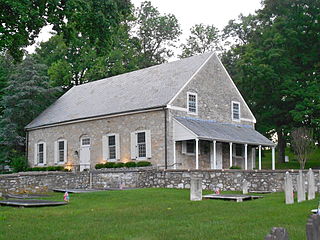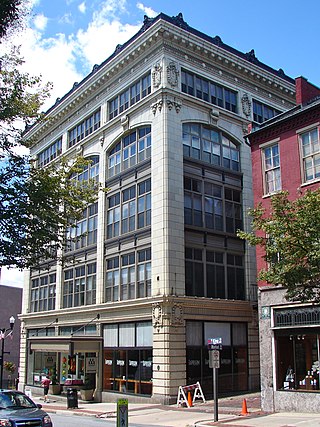
Lancaster is a city in and the county seat of Lancaster County, Pennsylvania, United States. With a population of 58,039 at the 2020 census, it is the tenth-most populous city in the state. It is a core city within South Central Pennsylvania, with 552,984 residents in the Lancaster metropolitan area.

Paxtang is a borough in Dauphin County, Pennsylvania, United States. As of the 2020 census it had a population of 1,640. The borough is a suburb of Harrisburg and is one of the earliest colonial settlements in South Central Pennsylvania.
Conestoga or Conestogo may refer to:

The Susquehannock, also known as the Conestoga, Minquas, and Andaste, were an Iroquoian people who lived in the lower Susquehanna River watershed in what is now Pennsylvania. Their name means “people of the muddy river.”

The Paxton Boys, also known as the Paxtang Boys or the Paxton Rangers, were a mob of settlers that murdered 20 unarmed Conestoga in Lancaster County, Pennsylvania, in December 1763. This group of vigilantes from Lancaster and Cumberland counties formed in 1763 to defend themselves from Indigenous attacks during Pontiac's War. The Paxton Boys justified their actions by claiming that the Conestoga were colluding with the Lenape and Shawnee who were attacking Pennsylvania's frontier settlements. According to historian Kevin Kenny, the Paxton Boys were Pennsylvania's most aggressive colonists.

The Trocadero Theatre is a historic theater located in Chinatown in Philadelphia, Pennsylvania. It offered musical comedies, vaudeville, opera, and burlesque. The Trocadero Theatre was refurbished for use as an art house cinema and fine arts theatre in 1970s, and by the 1990s had become an iconic venue for rock and punk concerts.

The Stephen Collins Foster Memorial is a performing arts center and museum which houses the Stephen Foster Archives at the University of Pittsburgh in Pittsburgh, Pennsylvania, USA. It is dedicated to the life and works of American songwriter Stephen Foster.
The Cultural District is a fourteen-square-block area in Downtown Pittsburgh bordered by the Allegheny River on the north, Tenth Street on the east, Stanwix Street on the west, and Liberty Avenue on the south.

Conestoga is an unincorporated community and census-designated place (CDP) in Conestoga Township, Lancaster County, Pennsylvania, United States. At the 2020 census, the population was 1,163. The Conestoga post office serves ZIP code 17516.

Samuel Sloan was a Philadelphia-based architect and best-selling author of architecture books in the mid-19th century. He specialized in Italianate villas and country houses, churches, and institutional buildings. His most famous building—the octagonal mansion "Longwood" in Natchez, Mississippi—is unfinished; construction was abandoned during the American Civil War.
Captain Lazarus Stewart was an 18th-century Pennsylvanian frontiersman, a leader of the Paxton Boys, and a prominent commander on the Yankee side in the Pennamite–Yankee War. He met his death during the Revolutionary War in battle with Loyalists and Haudenosaunee at the Battle of Wyoming.

The Springer Opera House is a historic theater at 103 Tenth Street in Downtown Columbus, Georgia. First opened February 21, 1871, the theater was named the State Theatre of Georgia by Governor Jimmy Carter for its 100th anniversary season, a designation made permanent by the 1992 state legislature. The Springer has hosted legendary performers such as Edwin Booth, Oscar Wilde, Ethel Barrymore, Agnes de Mille, and bandleader John Philip Sousa. The building was added to the National Register of Historic Places in 1970 and named a National Historic Landmark in 1978 for its architecture and state of preservation.

Edwin Forrest Durang was an American architect. He kept offices in Philadelphia and specialized in ecclesiastical and theatrical design.

The Ramsdell Theatre is a historic playhouse theater building and opera house at 101 Maple Street in downtown Manistee, Michigan. The building was financed by local businessman and politician Thomas Jefferson Ramsdell and was built in 1902. It replaced the town's two previous opera houses which had been destroyed by fire, one in 1882 and the other in 1900. Besides producing plays the facility was later used as a movie theater. James Earl Jones started his acting career at the theater as an actor and stage manager.
Jeanne Clemson was an American artistic director, theater director, actress, educator and preservationist. Clemson was considered instrumental in the efforts to save the Fulton Opera House, located in downtown Lancaster, Pennsylvania, from demolition during the 1950s and 1960s. She is also credited with restoring live theater productions to the Fulton.

Great Minquas Path, or The Great Trail, was a 17th-century trade route that ran through southeastern Pennsylvania from the Susquehanna River, near Conestoga, to the Schuylkill River, opposite Philadelphia. The 80-mile (130 km) east-west trail was the primary route for fur trading with the Minquas people. Dutch, Swedish and English settlers fought one another for control of it.

Witmer's Tavern, is an historic structure that is located in East Lampeter Township, Lancaster County, Pennsylvania, just east of U.S. 30 on Old Philadelphia Pike. This building known as Witmer's Tavern should not be confused with the other Witmer's Tavern more commonly known as the Conestoga Restaurant or Conestoga Inn that is located on Route 462 at Bridgeport just east of Lancaster City.

Conestoga Town is an historic archaeological site memorializing the Native American tribal village which stood on the site from the late 17th into the mid-18th-century; it is located at what is now Manor Township in Lancaster County, Pennsylvania. The town is a settlement at the southern end of the once vast range of the Susquehannock nation or Conestoga Indian nation, which once extended from the northern reaches of Maryland to the along the southern width of southern New York State and southern Catskills where a related people, the Five Nations of the Iroquois Confederacy held western settlement in check for 200 years. Their territory encompassed the entire drainage basin of the Susquehanna River which shares the tribe's root name and extended to the drainage divides of the flanking mountains both to the East to the Delaware nation and to the West to Shawnee lands. The town is the earliest established known surviving settlement of the tribe, and it is known that William Penn himself visited to negotiate with the tribal leaders. The site is also one known to be among the last occupied of the Susquehannock town sites in Pennsylvania as they faded into obscurity.

Cassius Emlen Urban was a Lancaster, Pennsylvania-based architect. He was the leading architect in Lancaster from the 1890s to the 1920s.

The Bayview Opera House, formerly known as South San Francisco Opera House, is a theatre at 4705 3rd Street in Bayview-Hunters Point district in San Francisco, California, United States. Founded in 1888, it is reputed to be the oldest existing theatre in the city. From 2014 to 2016, the theatre underwent renovation.




















